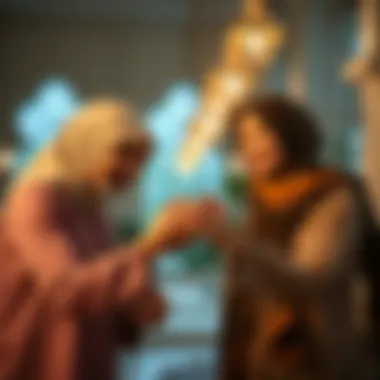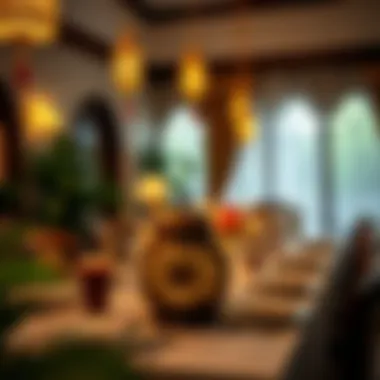Eid Greetings: Cultural Insights and Meaningful Connections


Intro
Eid, a time of celebration and reflection, transcends borders and cultures, creating a tapestry of greetings that resonate across continents. Whether it’s the warmth in a salaam or the joy in a heartfelt Eid Mubarak, these expressions hold significant meaning. They are more than just words; they're symbols of togetherness, respect, and genuine happiness among families and friends.
The diversity in Eid greetings can be likened to a rich aroma of spices blending in a traditional dish. Each region adds its own flavor, showcasing unique interpretations rooted in local customs and traditions. From the fervent celebrations in the Middle East to the vibrant expressions in South Asia, the greetings evolve, often showcasing the essence of the community’s spirit.
In contemporary society, the significance of these greetings continues to be ever-present. Social media plays a critical role in how communities engage during Eid, allowing individuals to share their joy and reach far beyond geographical limitations. This shift reflects not only the changing dynamics of communication but also underscores the enduring importance of connection during these festive times.
What follows is an in-depth exploration of Eid greetings, shedding light on various cultural expressions and the profound sentiments they encapsulate in today’s world.
Understanding Eid: Significance and Overview
Eid holds a pivotal place in the lives of Muslims all over the world. It is not merely a holiday; it encapsulates a period of spiritual reflection, devotion, and community bonding. This section aims to elucidate the significance of Eid, offering a clearer understanding of its multifaceted nature. The celebration represents a culmination of months of fasting and prayer during Ramadan, fostering a sense of achievement and gratitude among believers.
Eid al-Fitr: Celebrating the End of Ramadan
Eid al-Fitr marks the conclusion of Ramadan, a month drenched in fasting from dawn until dusk. This festivity serves as a joyful outlet for individuals to express their gratitude to Allah for the strength and perseverance shown during the fast. It carries a spirit of forgiveness and generosity, urging people to reach out to one another. Families typically come together, often preparing sumptuous meals and sharing festive sweets.
The essence of Eid al-Fitr is rooted in communal harmony. Gathering for prayers at mosques or open fields reinforces this sense of unity. Moreover, it is customary to give Zakat al-Fitr, a form of charity designed to purify those who fast, as well as ensure that all members of the community can partake joyfully in the celebrations. As families embrace one another and exchange warm greetings during this occasion, it further solidifies the bonds that hold communities together.
Eid al-Adha: Commemorating Tradition
Eid al-Adha honors the unwavering faith of Ibrahim (Abraham), who was prepared to sacrifice his son as an act of obedience to God. Instead, a ram was offered in his place. This holiday is characterized by the ritual of animal sacrifice, shared among those in need. In doing this, believers express their devotion and gratitude for God’s blessings. The meat from the sacrifice is commonly distributed, offering sustenance and fostering a spirit of compassion.
The importance of Eid al-Adha lies not just in its rituals, but also in the lessons it imparts about faith and sacrifice. Families, friends, and neighbors unite, reinforcing the notion that communal well-being supersedes individual desires. As they partake in meals together, they celebrate not only their faith but their collective human experience—solidarity, sacrifice, and shared destiny.
Cultural Variations of Eid
Eid celebrations are not monolithic; they vary significantly across cultures and regions, reflecting the unique traditions and customs of different communities. In South Asia, for example, Eid is often adorned with elaborate feasts, vibrant attire, and joyous gatherings that can last several days. In contrast, in parts of the Middle East, festivities may center around more modest gatherings coupled with communal prayers.
Here are some cultural variations:
- In Indonesia, the holiday is known as Lebaran, featuring special dishes like ketupat and rendang.
- In Turkey, the celebration is often referred to as Ramazan Bayramı, emphasizing family visits and sweets like baklava.
- East African nations may incorporate local delicacies that enrich their unique customs and practices.
Despite these differences, the underlying themes of joy, unity, and respect echo throughout. Each culture lends its own flair to Eid, enhancing its richness and deepening its significance as a universal observance.
"Eid is not just a ritual; it is the thread that binds communities together, a reminder of shared values across different cultural landscapes."
By exploring these aspects of Eid, we can appreciate the intricate tapestry of human connection it fosters, transcending geographical boundaries and cultural disparities.
The Essence of Eid Greetings
Eid greetings are more than simple exchanges; they encapsulate profound significance within various communities. The essence of these greetings lies not only in the words spoken but also in the feelings they convey. By expressing joy, fostering unity, and exhibiting respect, Eid greetings serve as a bridge connecting individuals, families, and cultures, reinforcing their bonds during this auspicious time.
Understanding the importance of Eid greetings is vital for appreciating the festival's rich heritage. These greetings symbolize shared beliefs and customs that date back centuries, shaping relationships and cultures. The emotions wrapped in these greetings can aid in strengthening ties, encouraging inclusivity among diverse groups. Thus, the essence behind them resonates deeply within the fabric of society, influencing human interactions broadly.
Moreover, the evolution of communication, especially in a rapidly modernizing world, reshapes how Eid greetings are conveyed, making this discussion essential for grasping both traditional values and contemporary practices.
Sentiments Behind the Greetings


Joy
Joy is the heartbeat of Eid greetings. It reflects the celebratory nature of the festival, emphasizing the happiness that comes from achieving spiritual goals and reuniting with loved ones. This joy is infectious, as it invites others to share in the delight of the occasion. One key characteristic of joy in this context is that it often leads to spontaneous expressions. People joyfully exchange greetings, creating a lively atmosphere filled with warmth.
A unique feature of this joy is its ability to dissolve barriers—be they cultural, social, or even geographical. When people exchange joyful greetings, it fosters a feeling of belonging, reinforcing a collective identity. However, it is worth noting that this sentiment can sometimes feel overwhelming, especially for individuals going through personal challenges during the festive season. Yet, at its core, the joy in Eid greetings remains a beneficial aspect, amplifying the spirit of togetherness.
Unity
Unity plays a critical role in Eid greetings, showcasing an unparalleled strength found in togetherness. As families and friends come together, the greetings exchanged highlight a sense of communal belonging and shared purpose. The essence of unity is reflected not just in family structures but also within broader community contexts, where diverse cultures converge during Eid.
One attractive aspect of unity in greetings is that it underscores collective achievements and aspirations. Using these greetings, individuals recognize their interconnectedness, reinforcing the bonds that unite them across cultural divides. A unique feature lies in how various communities adopt specific greetings that reflect their cultural nuances while simultaneously promoting shared values.
However, unity can pose challenges, particularly when cultural differences may lead to misunderstandings. Still, the overarching benefit of unity in Eid greetings is the cultivation of harmony and understanding among individuals, which enriches the overall celebratory experience.
Respect
Respect forms the foundation of Eid greetings, expressing appreciation for one another's traditions and values. The greetings honor the diversity that exists within communities while embracing the common reverence for Eid's significance. One key characteristic of respect in these exchanges is that it invites deeper connections among those involved, prompting people to engage meaningfully with one another.
The unique feature of respect in the context of Eid greetings is its ability to elevate the conversation beyond mere pleasantries, paving the way for genuine dialogue. This respectful interaction cultivates a safe environment for diverse opinions, beliefs, and practices. However, misinterpretations may arise if individuals are unfamiliar with each other's cultural backgrounds. Despite these potential challenges, respect remains a profoundly beneficial element of Eid greetings, as it encourages mutual understanding and reinforces the essence of community bonds everywhere.
Role of Greetings in Eid Celebrations
Eid greetings, in their various forms, hold substantial significance during celebrations. They act as a social lubricant, easing interactions between individuals, families, and communities. Such greetings serve to mark the occasion and acknowledge its importance while reinforcing communal ties. As people exchange warm wishes, they amplify the sharing of blessings and positivity that characterize the festival.
Moreover, these greetings often go hand in hand with other traditions, such as gift-giving and communal prayers. Their role extends beyond the personal; they create a collective experience that not only enriches the day but also builds a community’s identity.
In summation, Eid greetings encapsulate the essence of the festival's spirit, weaving a narrative of joy, unity, and respect. They serve as vital expressions that bind people across varied cultural landscapes, reflecting both the timeless traditions of the festival and its evolving nature in contemporary society.
Traditional Eid Greetings Across Cultures
Eid, a time of joy and celebration, brings various cultural expressions to the forefront, especially through greetings exchanged among friends and family. The significance of traditional Eid greetings across cultures cannot be overstated. They not only convey well-wishes but also reflect the values and sentiments intrinsic to the celebration. Recognizing the diversity in how Eid greetings are expressed enhances our appreciation for the rich tapestry of customs.
Culturally, these greetings serve several essential functions. First, they create a sense of belonging and unity, reinforcing communal ties. Second, they share cultural nuances that help outsiders understand the traditions better. Lastly, they preserve the historical context of the festival, maintaining the continuity of practices even in an ever-changing world. As we explore common Arabic phrases and regional variations, we uncover layers of meaning that enrich our understanding of Eid celebrations across the globe.
Common Arabic Phrases
Eid Mubarak
"Eid Mubarak" is perhaps the most recognized phrase associated with the celebration of Eid. Translated as "Blessed Eid," it captures the essence of what this festival means to many. The contribution of "Eid Mubarak" to this article is significant; it encapsulates the joy and good wishes associated with the festival. Its key characteristic lies in its universal application, making it suitable for any recipient. Whether said to a neighbor, a friend, or family, it resonates deeply with all.
The unique feature of "Eid Mubarak" is its straightforwardness; there are no layers of complexity, which makes it a popular greeting not just among Arabic speakers but also in many multicultural settings. Its advantage is clear: it fosters an immediate sense of positivity and warmth, bridging the gap between cultures, especially in diverse communities.
Eid Sa'id
Like "Eid Mubarak," "Eid Sa'id" is integral to Eid celebrations. This Arabic phrase means "Happy Eid" and carries a sense of heartfelt wish for joy. The specific aspect of "Eid Sa'id" is that it emphasizes happiness as a central theme of the celebration. Its contribution to this topic is pertinent, as it reveals the desire for not only personal joy but also communal happiness during Eid.
The phrase is characterized by its straightforward message, which makes it effective in any context. For many, "Eid Sa'id" is favored for conveying a heartfelt sentiment without the embellishments that sometimes accompany greetings. However, one could argue that its simplicity could be seen as less expressive compared to more elaborate greetings popular in other regions. Still, its effectiveness lies in its ability to communicate genuine happiness.
Regional Variations: A Global Perspective


The way Eid greetings are expressed varies widely across different cultures, showcasing the festival's adaptability and reach. For example, in South Asia, it's common to hear "Shukriya" coupled with Eid greetings, which translates to "Thank you," highlighting a spirit of gratitude. In Turkey, people often exclaim, "Bayramınız kutlu olsun!" which translates to "May your festival be blessed!"
These variations not only enrich the greeting but also serve to highlight cultural pride within the community.
- In Indonesia, people might use "Selamat Idul Fitri," reflecting the local language's influence.
- In Nigeria, greetings might blend Arabic with local dialects, such as saying "Eid Mubarak" alongside traditional expressions, showing a unique integration of cultures.
Understanding these regional differences is crucial for fostering connections among diverse communities. It allows individuals to appreciate not only the richness of language but also the shared values that underpin these greeting traditions.
As we recognize these varied expressions, we see how they encapsulate dreams and hopes, mingling with cultural integrity and a sense of belonging.
Eid Greetings in the Digital Era
In an age where communication happens at the speed of light, the traditions surrounding Eid greetings have not only persisted but have also transformed in unexpected ways. This shift isn’t just about sending messages; it’s about connecting hearts across distances. As communities grow increasingly global, the pressure to adapt cultural expressions within a digital framework rises. The advent of technology has altered the landscape of how these greetings are conveyed, making them more accessible yet still deeply rooted in cultural significance.
Evolution of Greetings through Technology
The journey of Eid greetings through technological advancements reflects society’s broader shifts. Initially, greetings were shared through personal visits and handwritten cards that conveyed warmth and sincerity. In today’s world, a simple text can travel across oceans in seconds.
- Text Messaging and Instant Communication: Text messages have made it possible for individuals to convey their sentiments quickly, but often lack that personal touch.
- E-Cards: Many opt for beautifully designed e-cards, infusing artistry into digital greetings — these carry both a personal touch and a contemporary feel.
- Video Messages: Video calls, especially during Eid, bridge distances effectively, allowing people to witness joy firsthand.
These advancements highlight how technology can be both a means of preserving tradition and a way of enhancing it. Yet, as seen in every societal change, it’s crucial to consider the implications of these new methods on genuine interpersonal connections.
Social Media and Eid
Social media platforms have become vital tools for transmitting Eid greetings in a manner that marries old traditions with new possibilities. With billions of users globally, sites like Facebook, Instagram, and even TikTok serve as modern-day marketplaces for cultural exchange. On these platforms:
- Sharing Experiences: Individuals showcase their celebrations through posts and stories, bringing the essence of their cultures into the digital realm for all to see.
- Virality of Greetings: Creative posts can go viral, allowing unique regional expressions of Eid to reach far wider audiences than ever before. This expands the understanding of varied cultural practices within the Muslim community.
- Local and Global Reach: Family and friends may be continents apart, yet they can connect instantly. This presents new opportunities for unity and cultural bonding through shared greetings and experiences.
"In our fast-paced world, Eid greetings serve as a reminder of the values that bring us together, highlighting the confluence between technology and tradition."
As we navigate the digital landscape, it’s imperative to strike a balance. Technology should not dilute the authenticity of Eid greetings, but instead enhance the meaningful connections they represent. Connecting through screens can sometimes feel less personal, so it remains essential to intertwine heartfelt messages with these advancements. Thus, celebrating Eid greetings in the digital age means embracing innovation while cherishing the sentiments behind them.
Crafting Thoughtful Eid Messages
Crafting thoughtful Eid messages goes beyond the simple act of sending good wishes. It is an opportunity to express one's sentiments and embrace the spirit of the holiday. These messages are not just words; they are an embodiment of feelings that can strengthen bonds between friends, family, and communities. In an age where digital communication often simplifies interactions, taking a moment to personalize greetings can add immense value to relationships.
Personalization in Greetings
Personalization is an essential aspect of meaningful Eid messages. When a message is tailored to a specific individual, it shows that the sender values the recipient's unique qualities and experiences. For instance, instead of sending a generic "Eid Mubarak" to everyone, individuals might reflect on shared memories or cultural traditions with each recipient.
- Thoughtful references: Incorporating memories shared during past Eid celebrations highlights special bonds. For example: "Remember last year when we made that delicious biryani together? Hope this Eid is just as memorable!"
- Cultural nuances: Recognizing the diverse traditions within the community can enhance the message’s impact. A non-Arabic speaker might still greet their Arabic friends in their native tongue, showcasing appreciation for their culture.
- Targeted affection: Including a personal touch, like mentioning their loved ones, can deepen emotional resonance. "I hope this Eid brings joy not only to you but also to your little ones!"
These approaches not only enrich the connection but also encourage feelings of unity and belonging.
Cultural Sensitivity in Messaging
Cultural sensitivity in crafting Eid greetings is paramount, especially in multicultural settings. It involves being aware of and respecting the diverse practices and beliefs surrounding Eid. Missteps can lead to misunderstandings or offend, which is counterproductive to the spirit of the occasion.
To be culturally sensitive, consider these factors:


- Awareness of different Eid practices: For instance, while Eid al-Fitr is often associated with communal prayers and feasting, Eid al-Adha has a different emphasis on sacrifice and charity. Tailoring messages to reflect these differences ensures respect.
- Language considerations: Using the appropriate language—whether it’s Arabic or a local dialect—can elevate the context of the greetings. A simple translation in the recipient's preferred language can signify respect and acknowledge their roots.
- Inclusive messages: Crafting messages that resonate with various communities by using neutral language or inclusive terms can foster a sense of togetherness. Instead of solely referencing religious aspects, one could mention shared hopes for peace, compassion, and prosperity for all.
Ensuring that Eid messages are crafted with thoughtfulness and respect enhances not only personal relationships but also the fabric of the broader community, encouraging connection, unity, and love.
Taking the time to personalize Eid messages and being culturally sensitive does not only elevate the joy during this festive time, but also cements bonds across diverse cultures.
By giving care to these elements, we ensure that Eid greetings reflect the true essence of the holiday—a celebration of unity and shared happiness.
For more insights into the significance of Eid greetings, you can visit Britannica or Wikipedia for a deeper understanding.
The Impact of Eid Greetings on Community Ties
Eid greetings have a profound impact on community ties, weaving a fabric of connection amid diverse cultures. These greetings are more than just a formality; they represent an intricate dance of sentiments such as joy, respect, and shared beliefs. By exchanging Eid greetings, individuals participate in a much larger tradition that firmly anchors them to their personal and communal identities.
The importance of Eid greetings transcends the act of merely saying words. They help to cultivate relationships and foster a sense of belonging within communities, whether they are homogenous or vary greatly in cultural backgrounds. A simple greeting like "Eid Mubarak" can spark conversation, nostalgia, and unity, essentially reinforcing one's relational bonds with others.
Fostering Connections among Diverse Communities
In a world that’s becoming more interconnected yet increasingly fragmented, the role of Eid greetings in fostering connections among diverse communities cannot be overstated. When people from various backgrounds send Eid wishes, they’re engaging in an exchange that highlights inclusivity and respect. This act helps to dismantle barriers that often stand between different cultures, making way for mutual understanding and appreciation.
- Emphasizing Common Values: Eid greetings often focus on universal themes like compassion, gratitude, and harmony. This makes it easier for people from various cultural backgrounds to relate to one another. When someone receives a heartfelt "Eid Mubarak", they're not just receiving a greeting; they are also receiving an invitation to celebrate shared values, regardless of cultural differences.
- Creating Spaces for Dialogue: The act of greeting can lead to more profound conversations about cultural practices, beliefs, and traditions. This dialogue creates pathways for intercultural interaction, fostering a strong sense of community. For instance, an expatriate interacting with a local might find commonality through their respective Eid practices, thus nurturing friendship and understanding.
Building Bridges: Eid in Multicultural Settings
Eid celebrations often take place in multicultural settings, which allows for vibrant exchanges and strengthening of community ties. In these contexts, the diversity of Eid greetings reflects a beautiful tapestry that showcases the wide spectrum of cultural expressions. Each greeting carries its own flavor, contributing to a richer Eid experience.
- Multifaceted Expressions of Greetings: As a result of globalization, people adapt traditional greetings to fit their local customs. For instance, in places like Indonesia and Malaysia, additional phrases are integrated alongside traditional Arabic expressions, enhancing the cultural significance and making the greetings unique to those communities.
- Encouraging Participation from All Sectors: The blending of cultures during Eid leads to greater inclusivity, as non-Muslims also join in the celebrations. This participation can foster respect and curiosity about traditions, promoting a healthier discourse between communities. When these greetings are shared within diverse settings, it serves to build bridges instead of walls, creating a lasting impact.
"Eid greetings act as a thread, connecting various cultures, fostering understanding, and celebrating diversity, making Eid a truly communal affair."
The influence of Eid greetings cannot be underestimated. As they transcend linguistic and cultural boundaries, these expressions serve as a reminder of what it truly means to be part of a community—a shared journey of connection, respect, and honor to a timeless tradition.
Ending: The Enduring Legacy of Eid Greetings
As we reach the closing pages of this exploration, it's clear that Eid greetings serve as more than just a customary exchange; they are a bridge across cultures, a tool for connection. Their significance extends beyond simple phrases; these greetings weave a tapestry of joy, unity, and respect that resonates through generations.
Reflections on Timeless Traditions
Eid greetings have a historical depth that holds value across different cultures. From the call of ‘Eid Mubarak’ echoing through bustling markets in Cairo to personalized messages exchanged in the quiet corners of a family home, these simple phrases encapsulate the essence of the celebration.
The traditions surrounding Eid greetings are often accompanied by rituals that reflect the values embedded in them. For instance, children eagerly anticipate receiving these greetings from family members and friends, as it symbolizes love and togetherness. The authenticity behind these messages, like hand-written notes or the shared laughter in person, enriches the emotional fabric of Eid.
Moreover, as families gather to share meals and stories, each greeting is an invitation to be part of a larger narrative, connecting the past with the present. It becomes a moment of reflection, reminding us of the rich history and beliefs that underlie the celebration of Eid.
"Eid greetings are the soul of the festivities, encapsulating a world of meaning in a few heartfelt words."
Looking Forward: The Future of Eid Greetings
In an ever-evolving world, the future of Eid greetings is intriguing. With technology's grip tightening, there's a significant shift towards digital expressions. While traditional greetings will always have their place, platforms like WhatsApp and Facebook have revolutionized how we convey sentiments.
This digital age brings both challenges and opportunities. The challenge lies in maintaining the personal touch that is often lost in a text message or an emoji. However, opportunities abound in creating new forms of engagement; virtual gatherings and video calls have sparked innovative ways to connect, allowing people distant in miles to come together in celebration.
As we look to the horizon of Eid celebrations, comprehensive approaches to inclusivity and cross-cultural engagement will shape how greetings are crafted. People from diverse backgrounds are increasingly blending their traditions, generating a rich mosaic of expressions that highlight the universal themes of love and respect.
In summary, the future holds the potential for Eid greetings to continually adapt while remaining rooted in the core principles that have defined them for centuries. As we navigate these dynamic landscapes, we must ensure that the heart of Eid greetings remains intact—reflecting joy, kindness, and solidarity across the globe.



